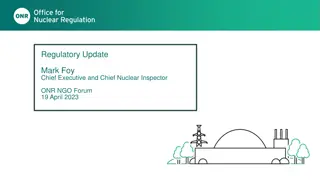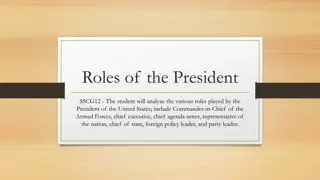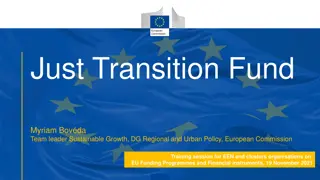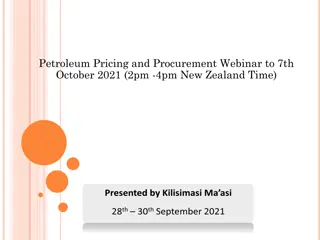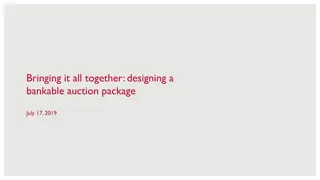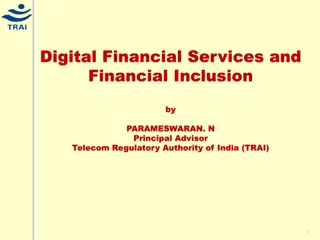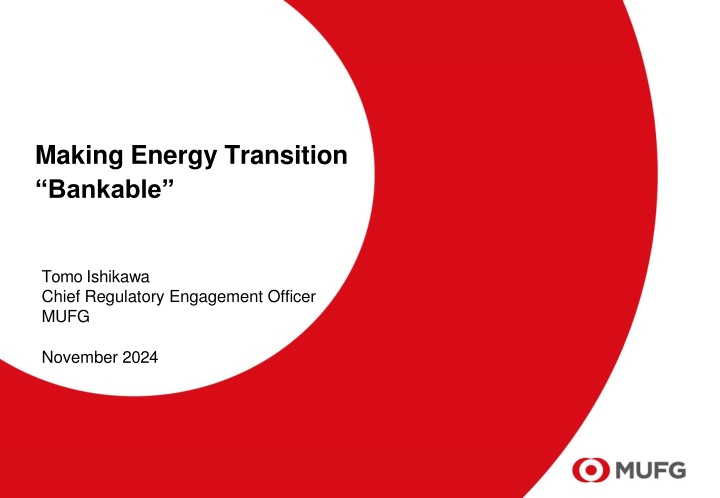
Energy Transition Bankable - Tomo Ishikawa, MUFG Chief Regulatory Engagement Officer
Tomo Ishikawa, Chief Regulatory Engagement Officer at MUFG, leads group-wide advocacy on financial regulatory policies, including climate change. With a background in advocacy, government relations, and sustainability programs, Ishikawa brings over 15 years of experience in regulatory policy and financial institutions. Learn about Ishikawa's role in spearheading MUFG's sustainability efforts and his contributions to global financial markets.
Download Presentation

Please find below an Image/Link to download the presentation.
The content on the website is provided AS IS for your information and personal use only. It may not be sold, licensed, or shared on other websites without obtaining consent from the author. If you encounter any issues during the download, it is possible that the publisher has removed the file from their server.
You are allowed to download the files provided on this website for personal or commercial use, subject to the condition that they are used lawfully. All files are the property of their respective owners.
The content on the website is provided AS IS for your information and personal use only. It may not be sold, licensed, or shared on other websites without obtaining consent from the author.
E N D
Presentation Transcript
Making Energy Transition Bankable Tomo Ishikawa Chief Regulatory Engagement Officer MUFG November 2024
2 MUFG Tomohiro (Tomo) Ishikawa Bio Tomo Ishikawa is Chief Regulatory Engagement Officer at MUFG. Ishikawa is responsible for orchestrating MUFG s group-wide advocacy strategy on financial regulatory policies, including prudential regulations and climate change. He oversees recovery/resolution planning for the group, and government relations across the regions. Prior to his current role, Ishikawa headed MUFG s Government and Regulatory Affairs (August 2018 - March 2023) based in Tokyo, and MUFG s Regulatory Strategy for the EMEA region (March 2017 July 2018) based in London. As part of MUFG s sustainability/climate change program, Ishikawa serves as a member of the Steering Group of NZBA (Net Zero Banking Alliance). He chairs the NZBA Transition Finance working group, which published the NZBA Transition Finance Guide in October 2022, Transition Finance KPI in December 2023, and Capital market target setting supporting note in October 2024. Ishikawa serves as a board member of GFMA (Global Financial Markets Association), representing MUFG. He is a member of Singapore MAS Sustainable Finance Advisory Panel (SFAP) since 2023. Until January 2017, Ishikawa headed the advocacy team on digital/technology policies within the Government & Regulatory Affairs Division at Deutsche Bank AG (based in London). Prior to joining Deutsche Bank in London, Ishikawa served as Deputy Director of Prudential Policy Office at Financial Services Agency of Japan (Japan FSA), where he led the derivative reform implementation. He chaired a work stream under the Working Group on Margin Requirement (WGMR), reporting to the BCBS & IOSCO Board, with the mandate to harmonize margin rules across the regions. Ishikawa started his professional career at Merrill Lynch as an investment banker. After 12 years at Merrill Lynch (Tokyo and NY), he moved to RECOF Corporation (a Japanese M&A boutique), and then to Deutsche Bank (financial institutions coverage banker based in Tokyo). He has 15 years of experience as a FIG investment banker, prior to becoming a regulatory policy expert. Ishikawa graduated from Keio University (Tokyo, Japan) in 1996. He lived in Toronto, Canada, prior to studying economics at Keio.
Part 1: Introduction
4 MUFG s Net Zero Commitment
5 MUFG s Global Footprint
6 MUFG s presence in ASEAN Since 2013, MUFG has invested more than US$14 billion in four strategic regional banks in Asia, creating a distinct MUFG advantage in this region. Through partner banks, MUFG has an expanded network of around 3,000 offices and branches combined that offer full corporate banking services. Vietnam Thailand Philippines Indonesia MUFG s Ownership 1 19.7% 3 76.9% 5 20.0% 10 92.5% 7 Domestic Ranking2 Branches & Offices3 1,113 76,240 MDY : Ba2 Fitch BB+ 615 72,123 MDY : A3 S&P : BBB+ Fitch : BBB BBB+ 316 15,234 MDY Baa2 JCR A- 864 Total Assets 4 (US$mil) 12,655 MDY : Baa1 Fitch : BBB Bank s Rating 1 Country s S&P Rating 1 BB+ BBB+ BBB Number of employees 22,789 34,806 7,882 25,883 (as of Dec 22/standalone) (as of Mar 23/group basis) (as of Mar 23/group basis) (as of Mar 22/group basis) 1 As of end Mar 2023 2 VietinBank, Security Bank: Based on Partner Bank s total asset (As of end Sep 2022); Krungsri: Based on Partner Bank s total asset (As of end Dec 2022); Danamon: Based on Partner Bank s profitability (revenue and NPAT as of Dec 2022) 3 VietinBank: As of end Dec 2020(Single); Bank of Ayudhya : As of end Dec 2022(Bank and auto subsidiary, two branches in Laos); Security Bank : As of end Dec 2022(Single); Danamon: As of end Dec 2022(consolidated), 4 As of end Dec 2022
7 MUFG s Carbon Footprint
8 MUFG s Involvement in the Global Net Zero Initiatives Net Zero Banking Alliance GFANZ MUFG has been reappointed for Steering Group (SG) member. The number of seats for Asia increased from 2 to 4, with CIMB and Maybank newly joining. Total number of SG members is 14. MUFG is participating in all 5 workstream, including co-chairing the Public Policy workstream Workstreams targeting either NY Climate Week or COP29 for announcing draft of consultations (nature + index), and reports Focus on newly formed Nature in Net-Zero Transition Plans with consultation draft WIP First Abu Dhabi Banks the chair and Amalgamated Bank serves as the Vice Chair of SG. MUFG has been chairing the transition finance working group. GFANZ Japan World Bank Private Sector Investment Lab MUFG serves as a chair of GFANZ Japan The purpose of GFANZ Japan : Bringing GFANZ Global to Japan, and Japan to Global MUFG has been the member of the Lab since the inception in September 2023.. The recommendation from the Lab to the World Bank leadership team led to the consolidation of the guarantee within the World Bank Group MIGA became the one stop shop platform for guarantee products. More tangible action to come.
9 Being a Rule-maker, not a Rule-taker MUFG has led discussions as the chair of the Transition Finance Work Track, and Capital Markets Working Group which NZBA established. Below 3 reports has been published October 2022, NZBA Transition Finance Guide NZBA Transition Finance Guide provides member banks with principles to use as a reference for their approach to transition finance and proposes policy measures to mainstream transition finance. December 2023, Developing Metrics for Transition Finance Aiming to scaling up transition finance, Developing Metrics for Transition Finance proposes that financial institutions quantify, grasp, and disclose the impact of transition finance to complement financed emissions metrics October 2024, Target Setting for Capital Markets Activities Target Setting for Capital Markets Activities builds on the PCAF Facilitated Emissions Standard while exploring options for the scope and methods of target setting, particularly for underwriting activities. Unlike lending, underwriting is characterized by its flow business nature, where the actual holding of the securities by financial institutions instantaneous, and subject to market volatility in terms of new securities issued. The report addresses these differences in the nature of lending and underwriting activities.
Part 2: Demystifying Bankability
11 Bank s Triple Missions A Trilemma ? REAL ECONOMY (2) Bank to Real Economy BANK (1) Net Zero Strategy (3) Real Economy to Bank Mission 1: Pursue net zero target Mission 2: Support real economy transition (opportunity & growth) Mission 3: Manage & mitigate climate related financial risks of existing exposures
12 The Role of Banks in Transition Finance Providing NewMoney Capital Market Financing Bank Lending Corporate Primary Market Corporate Secondary Market Equity/Debt Proceeds Money will not flow to the corporate (but provides market liquidity) Lending Investment Bank Bank Investors Equity/Debt Equity/Debt Primary Market Proceeds Purchase Banks provides money to corporates (or projects), contributing directly to transition/decarbonization Investors Investors Financing opportunities hinge on corporates demand for finance Investment assets are always available in the market (investors can allocate capital anytime)
13 Enablers & Attributes of Transition Finance Bank Lending Capital Market Financing Disclosure being key factor for investors Engagement being the key lever Identification of financing opportunities Transition plan is the basis for the investment decision Need to financing ideas and "win pitch Standardization & comparability Combination of client relationship & innovating financing solution Continuous engagement before & after financing transactions Third party verification preferable Various investment strategies Equity/bond (Green Bond) Active/passive Impact based / financial returns Engagement approach: Stewardship Engagement as an owner (equity investors) Role of transition plan & disclosure Transition plan (which is a living document) is the start of the conversation Engagement allows an access to additional information (more than disclosed)
14 Transition Finance: Transaction Lifecycle for Banks Identification of financing opportunities (e.g. new capex) Financing ideas proposed RFP process (in some instances) Mandate for a transaction Structure and terms agreed Due diligence (see next slide) 3 4 / credit decisions Follow up engagement after the transaction closed (e.g. KPI monitoring for sustainability-linked loans) Understanding client s transition plan (inc. capex plan) Benchmarking against peers & alignment with policy direction 2 5 Dialogues on transition opportunities start Client relationship provides an access to senior management 1 Continue to monitor (1) financial viability (sufficient cashflow is generated), and (2) emission reductions (thereby financed emission) decrease according to transition plans
15 Due Diligence Considerations Corporate Level & Transaction Level Corporate level transition plan credibility assessment Transaction level bankability assessment Vision & ambition Governance & senior management accountability Financial lens Business strategy (product offering) Cashflow projection Key technologies Capex plan Risk scenarios Environmental (net zero-focused) lens* Baseline emission profile analysis Emission reduction strategy (short, medium and long term) Alignment with 1.5c scenario (or other targets) Engagement strategy (supply chain, consumers, public policy) Financial bankability Cashflow analysis (repayment risk analysis) Technology/operator track record on cashflow generation Collateral (including physical risk analysis) Traditional approach Non-financial (environmental/net zero) bankability Analysis of use of proceeds (for project-finance) Alignment with the macro-level policy (e.g. government policy, technology roadmap) Application of the MUFG Environment & Social Policy Key takeaways: Need to proactively engage our clients to pitch financial solutions and win the opportunities Corporate level & transaction level assessment necessary Need to satisfy (1) financial bankability , and (2) environmental/net zero bankability * While this slide only covers environmental/netzero related impact (ie. mitigation), additional sustainability (and social) lens will be applied as appropriate (e.g. adaptation, nature, bio-diversity, circular economy, human rights)
Conclusion: Making Energy Transition Bankable
17 Making Energy Transition Bankable Capital Mobilization (Transactions) Demand for finance Supply for finance Macro-level assessment National Transition Plan Checklist Growth/industrialization vs. decarbonization Industrial/fiscal policy levers to accelerate transition 1. Objective setting and strategic vision 2. Implementation strategy Micro-level assessment 3. Engagement and Just Transition Risk-adjusted return & impact Financial risk (credit, market etc) Reputational risks Competitive dynamics 4. Metrics and targets 5. Governance and transparency




